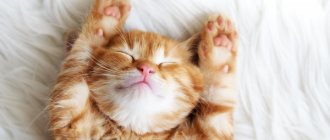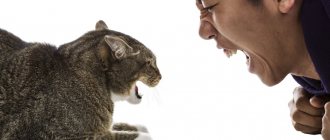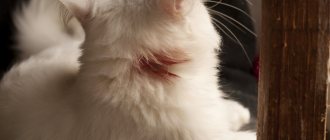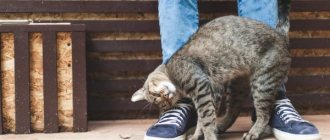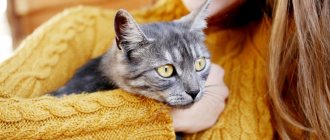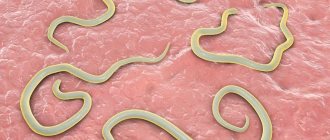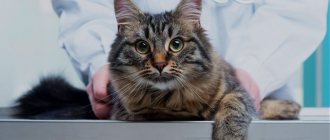Learn today about the symptoms and signs of diabetes in indoor cats. How to diagnose and treat.
Diabetes mellitus in cats is a chronic metabolic disease characterized by the inability of the animal's body to produce sufficient amounts of insulin. Insulin is a hormone responsible for balanced levels of sugar (glucose) in the blood. If the blood sugar level rises critically (hyperglycemia), this negatively affects the condition of all organs and systems.
In this material we will tell you why diabetes mellitus occurs in cats, what it is like, how it manifests itself, how it is treated, diet and whether it can be prevented.
What you need to know about the disease
Feline diabetes is a disease similar to humans. It has similar causes and clinical picture.
Why diabetes is dangerous
Without timely treatment, the disease leads to sudden weight loss, dehydration, problems with motor function, coma and death. The danger of the pathology is that it is detected late. By the time cats are diagnosed, they are usually already severely insulin dependent.
Risk group
Animals suffering from obesity and inflammation of the pancreas are at particular risk. There is no clearly defined age category for cats with diabetes. Although it has been noted that most often the disease occurs in middle-aged and elderly pets. The disease is more common in cats than in cats.
Insulin injection technique
The technique for administering insulin varies slightly depending on the length of the syringe needle or pen. You can form a skin fold or do without it, inject at an angle of 90 or 45 degrees.
- Prepare the drug, a new syringe or pen needle, cotton wool or a clean cloth.
- It is advisable to wash your hands with soap. There is no need to wipe the injection site with alcohol or other disinfectants.
- Draw the appropriate dose of medication into a syringe or pen.
- If necessary, form a skin fold with your thumb and index finger.
- Insert the needle at an angle of 90 or 45 degrees - this must be done quickly, with a jerk.
- Slowly press the plunger all the way down to inject the medication under the skin.
- Do not rush to remove the needle! Wait 10 seconds and only then remove it.
Should I wipe my skin with alcohol before injecting insulin?
There is no need to wipe the skin with alcohol before injecting insulin. Simply wash it with warm water and soap. Infection in the body during insulin injections is extremely unlikely. Provided that you use an insulin syringe or pen needle no more than once.
What to do if insulin leaks after an injection
There is no need to immediately give a second injection to replace the dose that leaked out. This is dangerous because it can cause hypoglycemia (low glucose levels). This assumes that you keep a diabetes self-management diary. In the note to the result of measuring sugar, record that insulin leaked. It is not a serious problem if it occurs rarely.
It is possible that your blood glucose levels will be elevated on subsequent measurements. When you get your next scheduled injection, give a higher dose of insulin than usual to compensate for the increase. Consider switching to longer needles to avoid repeated leakage incidents. After giving the injection, do not rush to remove the needle. Wait 10 seconds and only then remove it.
Many diabetics who inject themselves with insulin believe that low blood sugar and its terrible symptoms cannot be avoided. In fact, this is not true. It is possible to maintain stable normal sugar levels even with severe autoimmune disease. And even more so with relatively mild type 2 diabetes. There is no need to artificially increase your blood glucose levels to protect yourself from dangerous hypoglycemia. Watch this video of Dr. Bernstein discussing this issue with the father of a child with type 1 diabetes. Learn how to balance your diet and insulin doses.
Causes of the disease
The cause of diabetes in cats is a metabolic failure. The body produces little or no insulin, or cells stop noticing and responding to insulin.
Failure to comply with feeding standards, which causes obesity, is the main cause of diabetes in cats.
Factors causing this failure:
- obesity;
- unbalanced diet causing nutritional deficiencies;
- infectious pancreatitis and hepatitis;
- Gastrointestinal diseases: ulcers, gastritis, enteritis;
- chronic diseases of the liver and gall bladder;
- genetic predisposition;
- dysfunction of the thyroid gland;
- diseases of the adrenal cortex;
- stress;
- use of hormonal drugs.
Symptoms
Signs that should alert cat owners:
- excessive thirst;
- excessive urination (increased frequency and amount of urine);
- increased appetite or lack thereof;
- dull, sloppy coat;
- tachycardia;
- weight loss.
These are classic signs of diabetes in a cat, so don't hesitate to visit your veterinarian if you notice changes in your pet's condition.
When the condition is neglected, the animal develops wasting of the back muscles, weakness in the hind legs, lethargy, jaundice, convulsions, fainting, the smell of acetone from the mouth, and vomiting.
The cause of the disease can be dry food and Whiskas, so read how to wean your cat off dry food.
How to inject insulin during pregnancy
Women who have high sugar levels during pregnancy are first prescribed a special diet. If changes in diet are not enough to normalize glucose levels, you still need to give injections. No sugar-lowering pills should be used during pregnancy.
Hundreds of thousands of women have already undergone insulin injections during pregnancy. It has been proven to be safe for children. On the other hand, ignoring high blood sugar in pregnant women can create problems for both mother and fetus.
How many times a day is insulin typically administered to pregnant women?
This issue must be resolved individually for each patient, together with her attending physician. You may need one to five insulin injections per day. The injection schedule and dose depend on the severity of glucose metabolism disorders. Read more in the articles “Diabetes in Pregnancy” and “Gestational Diabetes”.
Treatment of diabetes in cats
Treatment of diabetes mellitus in cats is prescribed depending on the type and severity of the animal’s condition. The treatment regimen is comprehensive and includes the following main activities:
- Glycemic control. Restoring normal blood sugar levels.
- Normalization of weight. Eliminate signs of weight loss.
- Normalization of appetite.
- Elimination of thirst and frequent urination.
Adjusting the diet and introducing a special diet is a mandatory part of treatment.
For animals that are in satisfactory condition, the doctor selects the type of insulin, its dosage form (injections or tablets), dose and frequency of administration.
If an animal has ketoacidosis, a condition in which cells without glucose break down fats for energy, infusion therapy (intravenous drug administration) using short-acting insulin is necessary. Animals with ketoacidosis may require hospital treatment at a veterinary clinic.
After the condition has stabilized, it is possible that the doctor will advise the cat to have the ovaries and uterus removed, since it is difficult to control blood glucose levels during the animal’s sexual activity.
Depending on the type of insulin and the frequency of its administration, the frequency and feeding regimen may have to be changed. Giving up your usual food and switching to a special diet must be done gradually. Read the article on how to choose cat food.
The prognosis for an animal with diabetes is favorable, provided that all the doctor’s instructions are strictly followed - regular administration of medications, monitoring blood glucose levels, diet.
Insulin therapy
The basis of diabetes treatment is insulin therapy. For type I diabetes, short-acting insulin drugs are prescribed. For type II disease, medium- or long-acting insulin or glucose-lowering tablets are used.
Injectable insulin is used to treat cats. Oral hypoglycemic drugs do not control diabetes in animals well. Owners of cats with diabetes will have to learn how to give insulin injections. This shouldn't be scary. Over time, most owners get used to regular injections, which are vital for their sick pets.
How to properly give an insulin injection to a cat
It is best to inject insulin preparations into the side of the animal, since the skin there is thinner than at the withers. The animal will practically not feel the injection. This makes it easier to pierce the skin and make sure that the entire dose gets under the skin.
Video - how to give a subcutaneous insulin injection to a cat
Important!
Diabetes is treatable, but if left untreated, it is life-threatening for the cat.
Diabetes drugs
- Caninsulin is an aqueous suspension for injection based on purified porcine insulin. The dosage and frequency of administration are calculated by the veterinarian individually for each animal. You cannot change the dosage yourself. Price: 305 rub./190 UAH.
- Miglitol. The tablets slow down the absorption of glucose, thereby lowering blood sugar levels. The dosage is calculated individually for each cat by a veterinarian. Prescribed for type II diabetes. Price: 900 rub./287 UAH.
- Metformin. A hypoglycemic drug for the treatment of type II diabetes. Prescribed to obese cats. The dosage is calculated individually. Price: 93 RUR/25 UAH.
- Minidiab (Glipizide). Tablets to lower blood sugar levels. Prescribed if there is no effect from a low-carbohydrate diet for type II diabetes. Price: 2750 rub./660 UAH.
- Glyurenorm (Gliquidone). Sugar-lowering tablets for the treatment of type II diabetes. Price: 390 rub./252 UAH.
How to control your cat's sugar levels
To do this, use special test strips (to determine the level of sugar in the urine) and veterinary glucometers (to determine the level of glucose in the blood).
To use a test strip to measure the amount of glucose in your urine, simply dip the strip into your cat's waste.
How to correctly take a blood test with a glucometer from a cat
For animals, choose a veterinary glucometer or a glucometer “for babies” - this model requires a very small drop of blood.
- Blood for analysis is taken from the outside of the cat's ear (where the fur is). Before piercing, you need to rub your ear vigorously. This will make it easier to draw blood.
- There is no need to wipe your ear and instruments with alcohol. Disinfection of the ear is carried out after the puncture, having previously stopped the blood with dry sterile cotton wool.
- The puncture is done while holding the cat on your lap. The animal needs to be calmed down. Place something elastic (a roll of adhesive tape) on the side of the ear opposite the puncture.
- The needle can be used up to 5 times. After taking the analysis, it is treated with alcohol.
- After taking the test, you need to feed the cat.
Choosing a syringe for injection
Instruments for pets are purchased at a regular pharmacy for people. There are three types of injections: intramuscular, subcutaneous, intravenous. Each option requires different syringes and needles.
For intramuscular
In this case, the injection is carried out into the muscle of the cat's back or front leg. Syringe volumes are allowed: 1, 2, 5, 10 ml. If you need to administer a dose of more than 1 ml, you need to choose three-component syringes. In addition to the needle and piston, the design includes a plunger that allows the needle to move gently. The black seal is located at the end of the piston where the needle is inserted.
After choosing the correct volume, you should decide on the needle. For a cat and especially a kitten, it is better to choose thin needles. When choosing a syringe with a capacity of 2.5 ml or more, take a 30x0.6 mm needle or from an “insulin syringe”.
“Insulin syringes” work well with doses less than 1 ml. They got their name from the frequent administration of insulin to diabetic patients. The tool has two positive characteristics. First, it has a plunger for gentle movement. Secondly, the needle is short. Beginners should not worry about the depth of the needle.
Important! The needle must be very sharp. If she was getting medicine through the rubber stopper, the needle should be replaced.
For subcutaneous
In this case, the injection is made into the withers of the animal. Since the skin here is soft, not so stretched, it has few nerve endings. The cat feels less and, therefore, tolerates even painful injections well.
The volume of the syringe can be different, but the needle should be chosen 30x0.6 ml. This is the case if the medicine is not oil-based.
Often subcutaneous injections are accompanied by medications with an oily structure. To prevent the drug from clogging the passages in the needle, you need to choose needles of a larger diameter, since the oily and viscous structure of the drug hardens quickly. For example, if the syringe has a volume of 3 ml, then the needle should be selected 40x0.7 mm, etc.
Intravenous injection is carried out only by specialists.
Feeding cats with diabetes
A low-carbohydrate diet is an essential part of the diabetes treatment regimen. This type of diet improves blood glucose control. In veterinary practice, there are cases where insulin injections were discontinued for cats after switching to a low-carbohydrate diet. It is recommended to feed sick cats simultaneously with injections of insulin drugs.
Low carbohydrate diet with natural nutrition
Carbohydrates in the diet of cats diagnosed with feline diabetes should be no more than 5%. It should not contain baked goods, soy, corn porridge, rice, or wheat.
- The basis of the diet (50%) should be animal proteins: raw dietary meat: lean beef, turkey, rabbit, offal, tripe, chicken breast, boiled low-fat sea fish, chicken eggs.
- 25% – raw and thermally processed vegetables and fruits, except potatoes.
- 25% – fermented milk products: kefir (1%), low-fat cottage cheese, natural low-fat yogurt, fermented baked milk, cheese.
If cats are diagnosed with weight loss, the veterinarian may recommend feeding with several (3-4) meals per day or allow constant access to food. Weight loss programs can be developed for obese animals.
Food for diabetic cats
Industrial feeds recommended for diabetes:
- Young Again Zero Carb Cat Food – low-carb food;
- Hill's Prescription Diet M/D Feline Weight Loss-Low Carbohydrate-Diabetic dry – dry medicinal food;
- Hill's Prescription Diet w/d Digestive/Weight Management – wet canned food;
- Farmina Vet Life Feline Diabetic;
- Pro Plan Veterinary Diets Feline DM Diabetes Management dry;
- Brit Veterinary Diet Cat Grain Diabetes;
- Royal Canin Diabetic DS46.
Cats and diabetes
I thought for a long time whether to write this post. But at one time, when I was surfing the net looking for information, something like this would have helped me a lot. Just in case, I warn you: I am not a doctor, I am a cat owner. My advice is based on my experience and may not be universal. The treatment of the animal must be carried out by a veterinarian; each case must be assessed by a doctor based on the individual characteristics of the animal. However, in our world you cannot rely only on a doctor. Not all doctors are ideal; not all doctors have encountered diabetes, as practice has shown. And perhaps our experience and our mistakes will help someone else. So. If your pet is diagnosed with diabetes... 1. Oh horror? Do not panic. The wolf is not as scary as they make him out to be. There is nothing catastrophic about keeping a diabetic cat. One or two injections a day will not ruin your life. Now, after two months on insulin, I spend about two minutes on an injection. The cat Benita has already gotten used to it and is not indignant, although before she was held by two people and stabbed by a third. 2. Costs. Do not panic. Diabetes itself is not a reason to give up a cat. Insulin and dietary food are not financially burdensome. An ampoule of 3 ml of insulin lasts us for, say, a month. Diabetic food costs a little more than regular premium food, but you already feed your cat good food? 3. Is everything bad? No, really, don't panic. If your doctor tells you that diabetes will make your cat's life miserable, change doctors. After selecting the correct dose of insulin, life will return to normal. What has changed in our lives? Four minutes of injections a day, and yes, the cat is not allowed to steal food from the table. 4. What to do? The first thing that must be done is the selection of insulin and its dose. This cannot be done at home if you do not have experience and at least a couple of unemployed people. In order to select the dose of insulin, the cat needs to measure its blood glucose level every two hours for several days. If your doctor says you can measure once a day, change your doctor. We wasted two weeks. 5. Choice of insulin. We started with caninsulin. If you are in Ukraine, give up immediately; getting it is a controversial pleasure. One way or another, caninsulin did not help our cat. This does not mean that another will not work; the selection of insulin is an individual matter. I recommend Lantus to residents of Square. It is available in pharmacies of human hormonal preparations. The choice of insulin and its dose should be made by a doctor. 6. Inject with convenience. There are so-called syringe pens for insulin ampoules. I started injecting with regular syringes, now I use a pen. In my opinion, it is much more convenient. Not all syringes have the required number of divisions; to select a dose for a cat, you have to dial, say, “two and a half divisions” - by eye. In the syringe pen, the number of insulin units is set by scrolling the wheel. The same lantus in a syringe pen is no different in price from an ampoule. 7. Technique. You will need a glucometer in your home - this is a thing for measuring blood sugar. You can also buy urine test strips, but you won’t be able to do it without a glucometer. If you don’t want to buy something that isn’t the cheapest twice, choose your glucometer wisely. The most important thing is the amount of blood required for measuring and the prevalence of test strips. The first parameter is usually written in the characteristics of the device. Look for those that require less than 1 µmol of blood to measure. The cat will not tolerate it until you squeeze more blood out of it - it is painful and unpleasant. And often test strips are wasted due to lack of blood. Feel free to tell the store that you need a glucometer for your baby, they work well. Secondly, test strips, you will need a lot of them at first, and then you will have to buy more. So, when choosing a glucometer from a little-known company, you run the risk of not finding test strips. These two parameters, in my opinion, are the most important. Color, design and shape of the screen - your choice

